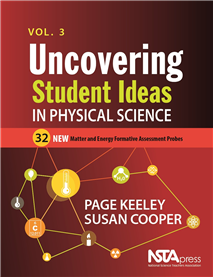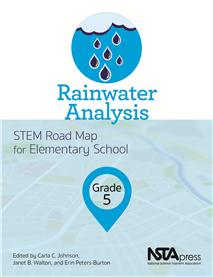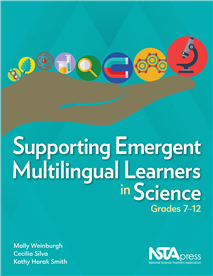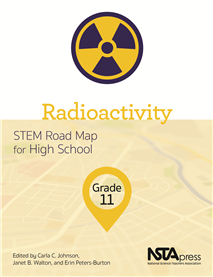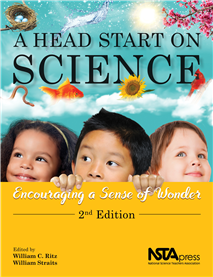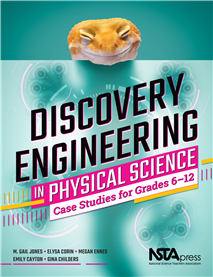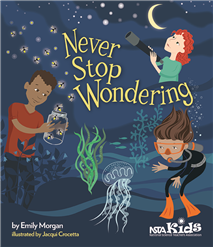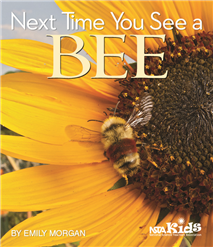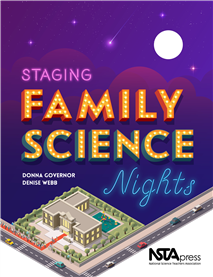All Book Chapters
Book Chapter
Do They Have Weight and Take Up Space?
The purpose of this assessment probe is to elicit students’ ideas about extensive properties. It is designed to determine whether students recognize that weight (or mass) and volume are extensive properties of the three familiar states of matter. T...
Book Chapter
What Does “Conservation of Matter” Mean?
The purpose of this assessment probe is to elicit students’ ideas about the phrase conservation of matter. It is designed to find out how students interpret the word conservation in the context of matter. The probe is best used with grades 5–12. ...
Book Chapter
The purpose of this assessment probe is to elicit students’ ideas about the conservation of matter. The probe is designed to find out if students conserve matter when salt is dissolved in water. It is best used with students in grades 3–12, with ...
Book Chapter
The purpose of this assessment probe is to elicit students’ ideas about density. The probe is designed to find out whether students recognize a change in the mass-volume ratio when the volume changes and the mass stays the same. It is best used wit...
Book Chapter
The purpose of this assessment probe is to elicit students’ ideas about density. It is designed to find out whether students have commonly held ideas about mass, volume, shape, and other properties that interfere with their conceptual understanding...
Book Chapter
The purpose of this assessment probe is to elicit students’ ideas about mass. It is designed to find out if students understand the difference between mass and other properties. The probe is best used with students in grades 6–12, and can be used...
Book Chapter
Do They Have the Same Properties?
This assessment probe is to elicit students’ ideas about microscopic and macroscopic properties of matter and is designed to find out if students attribute the same properties of a substance to the particles that make up the substance. The probe is...
Book Chapter
This assessment probe is to elicit students’ ideas about characteristic properties of matter. It is designed to find out if students recognize some properties can be used to identify a substance. The probe is best used with students in grades 6–1...
Book Chapter
The purpose of this assessment probe is to elicit students’ ideas about elements and compounds. It is designed to find out how students classify a common substance, water. The probe is best used with students in grades 5–12, preferably after they...
Book Chapter
Graphite is the material in a pencil tip, and diamonds are precious jewels. They are both made of carbon. This assessment probe is to elicit students’ ideas about two seemingly different substances that are composed of the same element. It is desig...
Book Chapter
The purpose of this assessment probe is to elicit students’ ideas about neutral atoms. The probe is designed to reveal how students think about the relationship between fundamental particles inside the nucleus of an atom. It is best used with stude...
Book Chapter
The purpose of this assessment probe is to elicit students’ ideas about substances. The probe is designed to determine whether students distinguish between the everyday use of the word substance and how chemists use the word to refer to matter with...
Book Chapter
When matter changes, sometimes a new substance is formed. The purpose of this assessment probe is to elicit students’ ideas about chemical change. The probe is designed to find out how students determine whether a new substance with a different che...
Book Chapter
What Is the Result of a Chemical Change?
The purpose of this assessment probe is to elicit students’ ideas about chemical change. The probe is designed to find out whether students recognize that substances change chemically as a result of a chemical reaction. It is best used with student...
Book Chapter
What Happens to Atoms During a Chemical Reaction?
The purpose of this assessment probe is to elicit students’ ideas about chemical change. The probe is designed to find out whether students recognize that the same kinds and numbers of atoms are present before and after a chemical reaction. It is b...
Book Chapter
Observations provide evidence of a chemical change. The purpose of this assessment probe is to elicit students’ ideas about chemical change. The probe is designed to find out what changes students use as evidence of a chemical change. It is best us...
Book Chapter
The purpose of this assessment probe is to elicit students’ ideas about changes that result in new properties. The probe is designed to find out whether students recognize that some things mixed together will retain their properties and others will...
Book Chapter
This assessment probe is to elicit students’ ideas about radiation and is designed to reveal whether students distinguish between something that had been exposed to radiation (irradiated) versus something that is radioactive. It is best used with s...
Book Chapter
This assessment probe is to elicit students’ ideas about radiation and is designed to reveal how students distinguish between irradiated and radioactive material. It is best used with grades 9–12 and should be followed up with opportunities for d...
Book Chapter
Energy is difficult to define. The purpose of this assessment probe is to elicit students’ ideas about energy and is designed to reveal how students define or describe energy. This probe is best used with students in grades 4–12. When used with ...
Book Chapter
This assessment probe is to elicit students’ ideas about matter and energy and is designed to uncover students’ ideas about the similarities and differences between the crosscutting concepts of matter and energy. This probe is best used with stud...
Book Chapter
This assessment probe is to elicit students’ ideas about energy and chemical bonds and is designed to find out how students think about the release of energy involved in chemical bonding. It is best used with grades 9–12, and it may help to provi...
Book Chapter
This assessment probe is to elicit students’ ideas about transfer of energy. It is designed to reveal whether students recognize that whenever there is a decrease in energy of a system, there is an increase in energy somewhere else. It is best used...
Book Chapter
The purpose of this assessment probe is to elicit students’ ideas about transfer of energy. The probe is designed to reveal whether students recognize heat can only move from warmer objects to cooler objects. It is best used with grades 6–12, and...
Book Chapter
The purpose of this assessment probe is to elicit students’ ideas about transfer of energy and is designed to reveal how students think about insulators. This probe is best used with grades 4–12, and if used with elementary students, the emphasis...
Book Chapter
The purpose of this assessment probe is to elicit students’ ideas about thermal energy. The probe is designed to reveal whether students distinguish between temperature and thermal energy. It is best used with grades 6–12. The probe is provided i...
Book Chapter
Rainwater Analysis, Grade 5: STEM Road Map for Elementary School (Book Sample)
What if you could challenge your fifth graders to design rainwater recycling systems to provide water for a fictional community garden? With this volume in the STEM Road Map Curriculum Series, you can! Rainwater Analysis outlines a journey that wi...
Book Chapter
Have you been wanting to probe your students’ thinking about major concepts in matter and energy? Have you been wishing for formative assessment tools in both English and Spanish? Then this is the book you’ve been waiting for. Like the other ...
Book Chapter
Supporting Emergent Multilingual Learners in Science, Grades 7–12 (Book Sample)
Many middle and high school teachers are educated to teach science content—they don’t anticipate that one day they may be teaching it to students who need to learn both content and English. If the day has come when you’re facing that two-pronge...
Book Chapter
Radioactivity, Grade 11: STEM Road Map for High School (Book Sample)
What if you could challenge your 11th graders to figure out the best response to a partial meltdown at a nuclear reactor in fictional Gammatown, USA? With this volume in the STEM Road Map Curriculum Series, you can!br> Radioactivity outlines a jou...
Book Chapter
A Head Start on Science, Second Edition: Encouraging a Sense of Wonder (Book Sample)
Imagine what fun it could be for 3- to 7-year-olds to engage in a game of Prism Play or Magnetic Scavenger Hunt or Where Did the Shadows Go? Then imagine how convenient it would be for you if such activities came with the connections, standards, and ...
Book Chapter
Discovery Engineering in Physical Science: Case Studies for Grades 6–12 (Book Sample)
Who knew that gecko feet inspired scientists to develop a stickier adhesive or that cockleburs in dog fur led to the invention of Velcro? Discovery Engineering in Physical Science uses these and other surprising cases of innovations sparked by accide...
Book Chapter
Understanding Climate Change, Grades 7–12 (Book Sample)
Get help teaching one of the hottest topics in science with Understanding Climate Change, Grades 7–12. This nine-session module is written to be practical and accessible. It provides both extensive background and step-by-step instructions for using...
Book Chapter
Never Stop Wondering (Book Sample)
Never stop wondering, never stop questioning. Never stop trying to figure things out. Always keep searching, always keep asking. That’s what science is all about....
Book Chapter
Next Time You See a Bee (Book Sample)
This book will get young readers buzzing about bees! Next Time You See a Bee reveals the big impact these little insects have on the world. It shows how the physical features of bees make them pros at collecting and spreading pollen. It explains how ...
Book Chapter
In this chapter, we discuss the various tasks and the human resources that you will need for a successful event, as well as what roles you need to fill and where to find the help you need. Because one of our primary strategies is to put students in c...
Book Chapter
In this chapter, information is presented about planning for the spaces you will use and the activities you will assign to each space. When designing your “set,” keep in mind specific needs for each activity. We have also included ideas for spec...
Book Chapter
In this chapter, we share and discuss a variety of extra touches you can include to give your event extra pizazz, such as branding, costumes, props, sprucing things up, and managing your costumes and props. It’s important to try to make each aspect...
Book Chapter
In this chapter, we discuss ways to integrate the community and its resources into your event, such as fundraising and getting the word out. We present you with some ideas for reaching out and including school and community resources, describe how to...
Book Chapter
In this chapter, we present the last-minute details and address challenges and obstacles that might arise on the night of your event. We will share how to handle last-minute items, such as safety and security concerns, as well as other things to watc...



